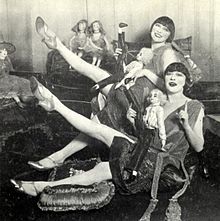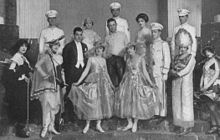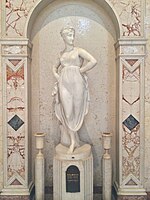Dolly Sisters
Rosie Dolly | |
|---|---|
 The sisters on stage | |
| Born | Rózsika Deutsch October 24, 1892 Balassagyarmat, Hungary |
| Died | February 1, 1970 (aged 77) New York City, U.S. |
| Resting place | Forest Lawn Memorial Park, Glendale |
| Occupation(s) | Dancer, actress |
| Years active | 1907–1929 |
| Spouses |
|
Jenny Dolly | |
|---|---|
 | |
| Born | Janka Deutsch October 24, 1892 Balassagyarmat, Hungary |
| Died | June 1, 1941 (aged 48) Hollywood, California, U.S. |
| Cause of death | Suicide by hanging |
| Resting place | Forest Lawn Memorial Park, Glendale |
| Other names | Jennie Dolly Yansci Dolly |
| Occupation(s) | Dancer, actress |
| Years active | 1907–1929 |
| Spouses |
|
| Children | 2 |
Rosie Dolly (October 24, 1892 – February 1, 1970) and Jenny Dolly (October 24, 1892 – June 1, 1941), known professionally as The Dolly Sisters, were Hungarian-American identical twin dancers, singers and actresses, popular in vaudeville and theatre during the 1910s and '20s. Both sisters also appeared in two silent films.
Early lives and careers
The sisters, Rózsika Deutsch (later known as Rose or Rosie) and Janka Deutsch (later known as Yancsi or Jenny), were born in Balassagyarmat, Hungary.[1] Their parents were Julius (born Gyula Deutsch, c. 1865) and Margaret Deutsch (born Margit Weisz, c. 1874). Julius and son Istvan (later known as Edward, born March 31, 1898) emigrated to the United States in October 1904; the twins and their mother arrived May 1905.[2] As children, the sisters trained as dancers and began earning money in beer halls as early as 1907. Barred for being under age by the New York City stage, they toured the Orpheum Circuit until 1909 when they debuted on the Keith Vaudeville Circuit.[citation needed]
The following year, they appeared in the stage production of The Echo. In 1911, Florenz Ziegfeld, Jr. signed them to appear in his Ziegfeld Follies for two seasons.[3] Their act was a hit with audiences who enjoyed their glamorous personas.[4]
In 1913, the sisters decided to try to forge separate careers. Rosie appeared in The Whirl of the World on stage while Jenny teamed up with dancer Harry Fox (whom she married in 1912) in Honeymoon Express.[4] Jenny and Fox also toured the vaudeville circuit as a dance duo.[5]
Both sisters made their film debuts in 1915: Jenny starred in The Call of the Dance and Rose appeared opposite Lillian Gish in Lily and the Rose (later reissued as The Tiger Lady). The sisters re-teamed in 1916 to appear in Ziegfeld's Midnight Frolic and returned to vaudeville where they commanded $2,000 a week. In 1918, they appeared in their only film together, the semi-autobiographical The Million Dollar Dollies.[4]
After World War I ended, the sisters moved to France where they bought a chateau. They toured the theaters and dance halls of Europe and were courted by numerous wealthy men and royalty including Carol II of Romania, Christian X of Denmark and Alfonso XIII of Spain.[6] On several occasions, the sisters would team up with male dance partners and sell tickets to the performances on the same night to create rivalry that would boost ticket sales.[3]
As their success continued throughout the early 1920s, they were able to command high salaries. During one engagement at the Moulin Rouge in Paris, the sisters were paid $1,200 a night.[7]

While in Europe, the sisters became well known for gambling excursions at casinos and horse tracks which were usually financed by wealthy admirers. They won $850,000 in one season at Deauville.[3] Of the two, Jenny Dolly became legendary for her winnings. She won 4 million francs one evening in Cannes, which she converted to a collection of jewelry; she then went on to win another $11 million.[3] On other occasions, she won $100,000 at the horse track, $500,000 at baccarat and $200,000 at roulette. With her winnings, Jenny Dolly indulged in her passion – buying expensive jewelry. Jenny's collection of jewelry, which she acquired through her winnings and from numerous suitors, became legendary.[citation needed]
While Jenny was gambling in Cannes one evening, the Viscountess Furness saw her and remarked, "I have never seen so many jewels on any one person in my life. Her bracelets reached almost to her elbows. The necklace she wore must have cost a king's ransom, and the ring on her right hand was the size of an ice cube."[8]
In 1926, the sisters staged a gala benefit concert for the nation of France at the Champs-Élysées theater. Participating artists included Josephine Baker, Harry Pilcer, and bandleader Billy Arnold.[9]
By early 1927, the Dolly Sisters' popularity began to decline. Their highly publicized Paris show A vol d'oiseau, closed after eight weeks.[8] The sisters spent more time gambling than performing and eventually retired by 1929.[citation needed]
Personal lives

The Dolly Sisters' private lives were as melodramatic as their public life was stellar. Rose Dolly was married three times while Jenny Dolly was married twice and had a string of highly publicized affairs with wealthy men. Their reputation for dating wealthy men earned them the nickname "The Million Dollar Dollies".[10]
In 1913, Rosie married songwriter Jean Schwartz. They divorced in 1921. Her second marriage was to Mortimer Davis, Jr., whom she married in 1927. Davis was the son of Mortimer Davis, the president of the Imperial Tobacco Company of Canada Limited. The senior Davis disapproved of the marriage and cut off Davis, Jr. Rosie and Davis divorced in 1931. Rosie's final marriage was to merchant Irving Netcher in 1932. They remained married until Netcher's death in 1953.[6]
Jenny's first marriage was to her dancing partner Harry Fox in 1912. They too divorced in 1921. In 1925, the sisters met retail magnate Harry Gordon Selfridge while they were performing in London. Jenny began an affair with Selfridge (Rosie also reportedly had an affair with him). Selfridge lavished Jenny with expensive gifts and funded both sisters' gambling habit. The Dolly Sisters reportedly gambled approximately $4 million of Selfridge's money away.[11] While she was still involved with Selfridge, Jenny Dolly began seeing French pilot Max Constant. In 1933, Selfridge offered Jenny $10 million to marry him.[citation needed]
Accident
Before she gave Selfridge an answer, she decided to go on one last holiday with Constant.[6] While the two were returning to Paris, Constant crashed the sports car in which they were traveling near Bordeaux. Jenny sustained serious injuries (her stomach had been displaced into her lung chamber) that required dozens of operations and plastic surgeries to reconstruct her face.[12]
To pay her medical expenses, Jenny sold off a portion of her jewelry collection. After the majority of Jenny's financial earnings were wiped out, Selfridge paid for Jenny's medical treatments although the two never married.[6]
Later years and deaths

After the car accident, Jenny Dolly developed depression.[6] Her depression increased when she was forced to sell the remainder of her jewelry at auction in 1936.[7] After living abroad for nine years, Jenny returned to the United States when her sister invited Jenny to live with her and her husband, Irving Netcher, in Chicago. There, Jenny met Bernard Vinissky, a wealthy lawyer;[6] the two were married on June 29, 1935.
Vinissky later adopted the two Hungarian orphans, Klári (1924–2013) and Manczi (1925–1985), whom Jenny had adopted in 1929.[12] The marriage did little to alleviate Jenny's depression, however, and the couple separated.[13] Jenny took an apartment in Hollywood with her two daughters.[12] On June 1, 1941, she hanged herself from a curtain rod in their apartment.[14]
In the years following their retirement and her sister's death, Rosie Dolly retreated from public life. With no children of her own, she spent her remaining years doing charitable work for children in her native Hungary.[6] In 1962, Rosie, too, attempted suicide.[3] On February 1, 1970, she died of a heart attack in New York City at the age of 77.[15]
The bodies of both sisters are interred in the Great Mausoleum at Forest Lawn Memorial Park, Glendale, California.[16]
Dolly Sisters filmography
| Year | Title | Role | Notes |
|---|---|---|---|
| 1914 | Our Mutual Girl | Themselves | episode 28 |
| Our Mutual Girl, No. 28 | Short film | ||
| 1916 | Hearst-International News Pictorial, No. 67 | Themselves (as The Dolly Sisters) | |
| Hearst-International News Pictorial, No. 70 | Themselves (as Rozsika Dolly and Tansci Dolly) | ||
| 1918 | The Million Dollar Dollies |
Rosie Dolly filmography
Film
| Year | Title | Role | Note |
|---|---|---|---|
| 1915 | The Lily and the Rose | Rose (as Rozsika Dolly) | Short film |
| Dance Creations | Self (as Rozsika Dolly) |
Television
| Year | Title | Role | Notes |
|---|---|---|---|
| 1958 | Person to Person | Herself | episode #6.5 |
Jenny Dolly filmography
| Year | Title | Role | Notes |
|---|---|---|---|
| 1915 | The Call of the Dance | Natalie Hall - a Child of the Slums (as Yancsi Dolly) | Short film |
Cultural references
In 1945, 20th Century Fox released the sanitized biographical film The Dolly Sisters. June Haver portrayed Rosie, and Betty Grable portrayed Jenny.[17]
In Anthony Powell's 1951 novel A Question Of Upbringing, some schoolboys discuss whether the Sisters might actually be mother and daughter.[18]
In 1972, the twenty-fourth episode of the fifth season of The Carol Burnett Show featured a musical comedy sketch of the sisters' lives called "The Doily Sisters", with Carol Burnett as Jenny, Vicki Lawrence as Rosie and Harvey Korman as Henry.[19]
Author Terry Pratchett chose to name a part of his fictional city Ankh-Morpork on the Discworld "Dolly Sisters".[citation needed]
The exploits of the Dolly sisters and their respective relationships with Harry Selfridge are chronicled on the TV series Mr Selfridge. It was indicated the expression 'dolly birds' arose from this period.[citation needed]
In the 1987 Last of the Summer Wine episode, "The Ice Cream Man Cometh", Compo Simmonite, seeing Nora Batty and Pearl come into the Cafe in a bad mood, says "Here come the Dolly Sisters!"[20]
Sources
- ^ Green, Stanley (2009). Encyclopedia of the Musical Theatre. Da Capo Press. p. 102. ISBN 978-0-786-74684-2.
- ^ Gyula Deutsch (born Siofok c. 1865); Margit Weisz (born Balassagyarmat c. 1874) (Son Istvan's birth record). István (later known as Edward) born Bajza ut 23, in district VI of Budapest, on March 31, 1898 (per Budapest birth records). Father and son arrived in the US in October 1904. Mother and daughters arrived in May 1905 (per Ellis Island Records).
- ^ a b c d e Knowles, Mark (2009). The Wicked Waltz and Other Scandalous Dances: Outrage at Couple Dancing in the 19th and Early 20th Centuries. McFarland. p. 316. ISBN 978-0-786-45360-3.
- ^ a b c Cullen, Frank; Hackman, Florence; McNeilly, Donald (2004). Vaudeville Old & New: An Encyclopedia Of Variety Performances in America, Volume 1. Psychology Press. p. 316. ISBN 0-415-93853-8.
- ^ Frasier, David K. (2002). Suicide in the Entertainment Industry: An Encyclopedia of 840 Twentieth Century Cases. McFarland & Company Incorporated Pub. p. 87. ISBN 0-786-41038-8.
- ^ a b c d e f g Cullen 2004. pg. 317.
- ^ a b Phillips, Alastair (June 2, 1941). "Jenny Dolly Of Dancing Team Suicide". San Jose News. p. 8. Retrieved March 23, 2014.
- ^ a b Woodhead, Lindy (2013). Shopping, Seduction & Mr. Selfridge. Random House LLC. p. 223. ISBN 978-0-812-98505-4.
- ^ St. Louis Globe-Democrat September 2, 1926 (pg. 2)
- ^ Woodhead 2013. p. 202.
- ^ Phillips, Alastair (January 13, 1990). "Shuffling off temptation to shorten odds". The Glasgow Herald. p. 23. Retrieved March 23, 2014.
- ^ a b c "Jenny Dolly Found Hanged; Illness Cited". The Pittsburgh Press. June 2, 1941. p. 6. Retrieved March 23, 2014.
- ^ "Jenny Dolly, Once-Famous Dancer, Commits Suicide". The Toledo Blade. June 2, 1941. p. 2. Retrieved March 23, 2014.
- ^ "Jenny Dolly of Sister Team Dead". The Milwaukee Sentinel. June 2, 1941. p. 8-B. Retrieved March 23, 2014.[permanent dead link]
- ^ Vazzana, Eugene Michael (2001). Silent Film Necrology. McFarland & Company Incorporated Pub. p. 139. ISBN 0-786-41059-0.
- ^ Ellenberger, Allan R. (2001). Celebrities in Los Angeles Cemeteries: A Directory. McFarland & Company Incorporated Pub. p. 46. ISBN 0-786-40983-5.
- ^ "When Dolly Sisters Were Toast of Two Continents". The Sydney Morning Herald. November 27, 1945. p. 11. Retrieved March 23, 2014.
- ^ Powell, Anthony (1951). A Dance to the Music of Time 1st Movement. University of Chicago Press. p. 38. ISBN 0-226-67714-1.
- ^ "The Carol Burnett Show (1967–1978) Episode #5.24". IMDb. Retrieved October 10, 2018.
- ^ Roy Clark (1987) Last of the Summer Wine: The Ice Cream Man Cometh (BBC Video)
Further reading
- Chapman, Gary. The Dolly Sisters: Icons of the Jazz Age
External links
- Dolly Sisters at the Internet Broadway Database
- Rosie Dolly at the Internet Broadway Database
- Jenny Dolly at the Internet Broadway Database
- Rosie Dolly at IMDb
- Jenny Dolly at IMDb
- Streetswing.com's Dolly Sisters page
- Page of the Lansdowne Club - Was Dolly Sister's London home in 1920s.
- Life of the Dolly Sisters focusing on their years in France and Deauville, with images.
